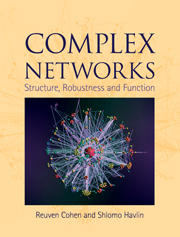Book contents
- Frontmatter
- Contents
- 1 Introduction
- PART I RANDOM NETWORK MODELS
- PART II STRUCTURE AND ROBUSTNESS OF COMPLEX NETWORKS
- PART III NETWORK FUNCTION: DYNAMICS AND APPLICATIONS
- 13 Optimization of the network structure
- 14 Epidemiological models
- 15 Immunization
- 16 Thermodynamic models on networks
- 17 Spectral properties, transport, diffusion and dynamics
- 18 Searching in networks
- 19 Biological networks and network motifs
- Appendix A Probability theoretical methods
- Appendix B Asymptotics and orders of magnitude
- Appendix C Algorithms for network simulation and investigation
- References
- Index
15 - Immunization
from PART III - NETWORK FUNCTION: DYNAMICS AND APPLICATIONS
Published online by Cambridge University Press: 05 August 2013
- Frontmatter
- Contents
- 1 Introduction
- PART I RANDOM NETWORK MODELS
- PART II STRUCTURE AND ROBUSTNESS OF COMPLEX NETWORKS
- PART III NETWORK FUNCTION: DYNAMICS AND APPLICATIONS
- 13 Optimization of the network structure
- 14 Epidemiological models
- 15 Immunization
- 16 Thermodynamic models on networks
- 17 Spectral properties, transport, diffusion and dynamics
- 18 Searching in networks
- 19 Biological networks and network motifs
- Appendix A Probability theoretical methods
- Appendix B Asymptotics and orders of magnitude
- Appendix C Algorithms for network simulation and investigation
- References
- Index
Summary
In general, immunization can be seen as a site percolation problem. Each immunized individual can be regarded as a node that is removed from the network. The goal of the immunization process is to pass (or at least approach) the percolation threshold, leading to minimization of the number of infected individuals. The complete model of SIR and immunization can be considered as a site–bond percolation model, and the immunization is considered successful if the network is below the percolation threshold.
It is well established that immunization of randomly selected individuals requires immunizing a very large fraction, f, of the population, in order to arrest epidemics that spread upon contact with an infected individual [AJB00, AM92, CEbH00, HA87, MA84, PV01b, WY84]. Many diseases require 80%–100% immunization. For example, measles requires 95% of the population to be immunized [AM92]. The same is true for the Internet, where stopping computer viruses requires almost 100% immunization [AJB00, CEbH00, KWC93, PV01b]. On the other hand, targeted immunization of the most highly connected individuals [AJB00, AM92, CEbH01, CNSW00, LM01, PV02], while effective, requires global information about the network in question, rendering it impractical in many cases.
In this chapter we present a mathematical model and propose an effective strategy, based on the immunization of a small fraction of random acquaintances of randomly selected nodes [CHb03]. In this way, the most highly connected nodes are immunized, and the process prevents epidemics with a small finite immunization threshold and without requiring specific knowledge of the network.
- Type
- Chapter
- Information
- Complex NetworksStructure, Robustness and Function, pp. 161 - 172Publisher: Cambridge University PressPrint publication year: 2010

